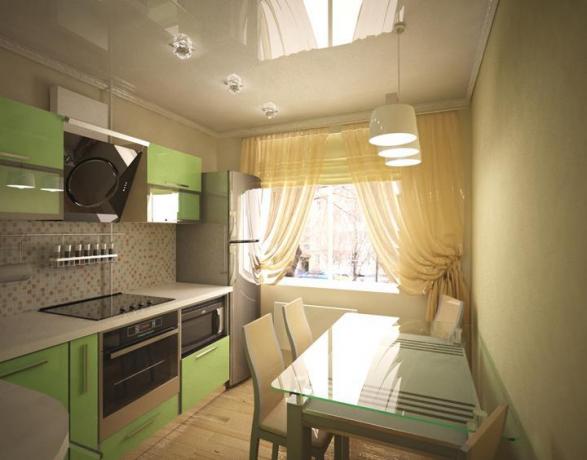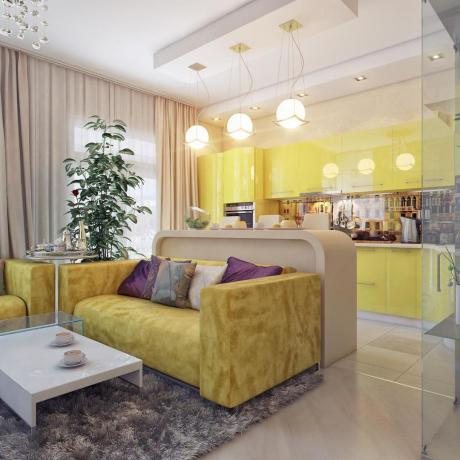Content
- 1 Types of wiring
-
2 Types of sockets
- 2.1 Hidden sockets
- 2.2 External sockets
- 3 Professional advice
-
4 We put the sockets ourselves
- 4.1 Getting started
- 4.2 Installing the outlet
- 5 Summarize
Modern kitchens are more than just a cooking room. If the hostess loves to cook and uses the most modern household appliances for this, then the kitchen is more like the board of a spaceship or the house of the future.
And in order to provide the most comfortable conditions for such a creative process, it is necessary to take care of compliance of the total power of electrical appliances with the cross-section of electrical wiring, the presence of protection devices and the location of outlets and switches.
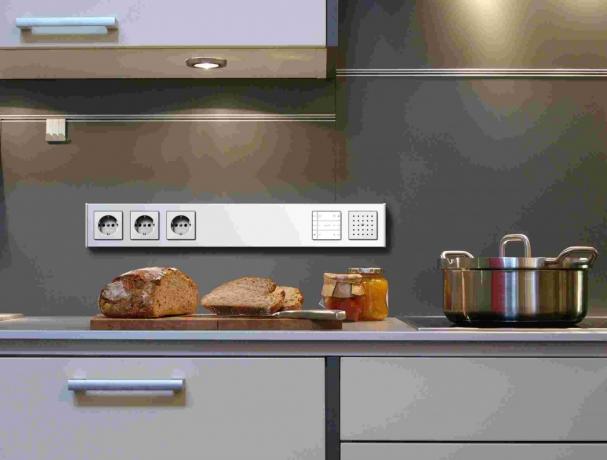
Sockets for kitchen appliances
Let's approach the issue more rationally and deal with everything in order. As with the installation of any network, which includes the installation of outlets in the kitchen, work should begin with drawing up a diagram. Think about what material you already have, write a list of all the essentials, focusing on your financial capabilities.
Read more in the material Placing sockets in the kitchen - recommendations and advice.
Remember!!! Partial wiring replacement and complete wiring replacement are completely different concepts. Each type of such activity should be considered as a separate type of work and all safety requirements should be met.
Types of wiring
Consider yourself lucky if you have a three-phase network in your house. This happens in cases when electric stoves are installed in apartments, instead of gas ones. With such a power grid, you do not have to worry about the proper operation of household appliances - there is enough voltage for all devices (even those turned on at the same time).
If your apartment has a single-phase network, then you will have to sacrifice some of the needs and amenities. Judge for yourself, if the voltage of a single-phase network is 50A, then the maximum power of your electrical network is 50A × 220V = 11 kW. And a three-phase network triples the power.
Additional Information - How many sockets do you need in the kitchen: calculation according to household appliances.
Types of sockets
If you prepared for the repair correctly, then you should have in your hands a diagram of sockets in the kitchen, based on which you can choose the right material for work. The basis for the correct choice of outlets is that you need to buy only models with a current of at least 16A.
Ideally, if the rosettes will have a ceramic base, as well as spring-loaded or nickel-plated lamellas in their design. This will significantly extend their service life. The price for the best and most reliable sockets is not high - it varies between 100-150 rubles.
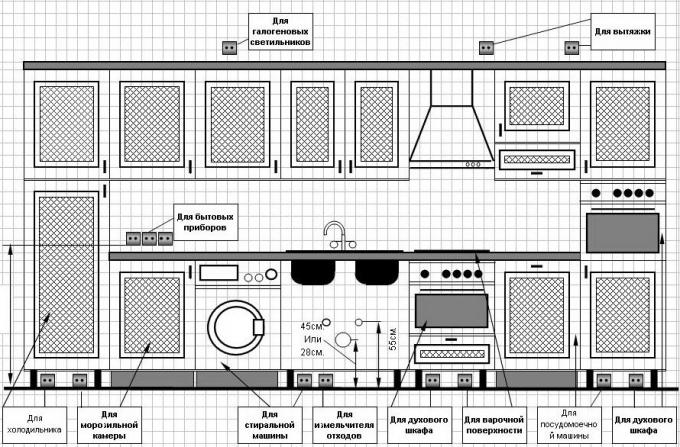
A variant of the scheme of sockets for a multifunctional kitchen
Hidden sockets
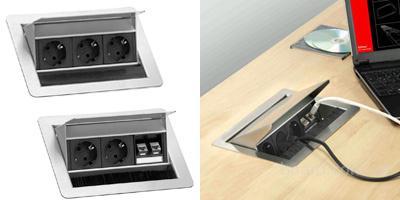
Hidden sockets
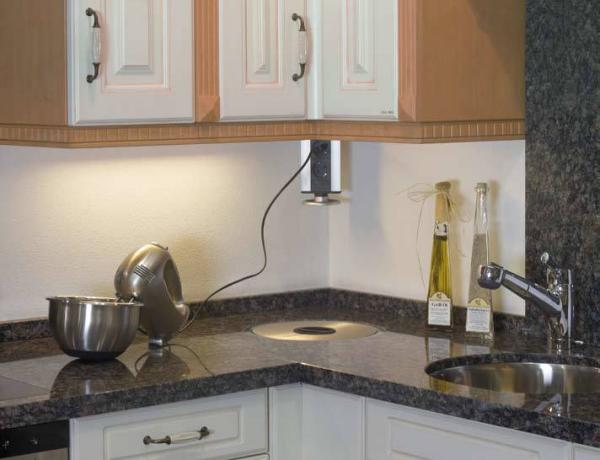
Hidden socket in the interior of the kitchen
Where to install the sockets in the kitchen? When ordering a new kitchen unit, take into account the location of cabinets and shelves, its design features and approximate dimensions (better accurate). This will help you easily navigate the location of the outlets.
Attention!!! Hidden sockets (built-in) are those that are not striking and are not visible to a technically “unsophisticated” person.
As mentioned above, the best solution would be to draw up a detailed plan, according to which you can most accurately and reasonably install new hidden sockets.
The main set of household appliances, for which you need sockets:
- Gas stove lighting (headset);
- Fridge;
- Hood and its lighting (see.Electric hoods for the kitchen: application features);
- Microwave (it is better to install a double socket).
A double socket can be installed under a refrigerator - many modern inhabitants often use a refrigerator as a TV stand, and a double socket will come in handy.
Knowing the dimensions of the new kitchen furniture, you can install the sockets in advance (then all that remains is to make the necessary cutouts in the back walls).
Attention!!! Professional electricians recommend installing the sockets in steps of 2-2.5 m from each other.
External sockets

Kitchen with external sockets
Everything seems to be clear about hidden switches, but how to properly install sockets in a non-built-in kitchen? In general, external sockets are classified into two types:
- Addicted (depending on the location of furniture and household appliances in the kitchen);
- Independent (do not depend on the arrangement and furnishings of the kitchen);
As independent sockets, you can specify those that are intended for coffee makers, toasters, for electronic clock and TV (some craftsmen mount such sockets directly on the tabletop, for increased comfort). Most often, they are located at a height of 12-15 cm from the table top.
The wiring of sockets in the kitchen (independent) completely depends on the location of household appliances - an electric kettle, a refrigerator, a TV and a dishwasher: these are the devices that dictate the rules.
Note!!! It is necessary to correctly and correctly calculate the number of outlets in the kitchen. Experts in no way recommend using all kinds of tees and extension cords that can contribute to the occurrence of a short circuit in the network.
As for dependent outlets, it is customary to install them at the same height around the perimeter of the entire room (no higher than 30 cm from the floor) - this will be very convenient and also aesthetically pleasing.
Professional advice
Now let's listen to the opinion of experts who share their life experience and professional skills:
- The average installation height of sockets in the kitchen is 30-40 cm from the floor. But here, too, there are certain nuances: sockets are installed for household appliances, so you need to adapt them, first of all, for the minimum load and maximum efficiency. For example, an outlet for an exhaust hood can be installed at a height of 180-200 cm from the floor, sockets for a microwave oven, toaster and food processor - 10-15 cm from the table top. There are no hard and fast rules!

In this diagram, sockets for household appliances are installed as conveniently as possible.
- Where to install sockets in the kitchen? If you do not have a plan for the location of the outlets, then experts recommend installing one on each wall - just in case;
- Many kitchens are equipped with landline phones, so do not forget about a special socket for it;
- The number of switches and sockets in the kitchen is not standardized by any act and document, so if you wish, you can not limit yourself and put as many sockets as you need.
We put the sockets ourselves
More recently, the question of how to install sockets in the kitchen was practically not heard. Everything was extremely simple - you hollow out a hole and insert a socket into it (the release was done with the help of special "paws" or everything was simply filled with mortar). There was one drawback in such outlets - in order to change it, you had to re-hammer the walls.
Now there is no need to do such work. Now the installation of electrical power points in the kitchen begins immediately with the installation of the cable.

Ready place for an outlet
Getting started
How to install sockets in the kitchen? Everything is simple - like any work, we start the installation of outlets with marking.
- A dot is marked on the wall to indicate the center of the socket. After marking the location, it is necessary to outline the contour of the box - for this we put the bottom of the box against the wall and outline its outline with a pencil (marker, pen). The outline for the outlet is ready and it remains only to hollow it out.
- After drilling and slotting, you need to carefully align the contour with a chisel. Specialists, for making holes for sockets, use a special drill for concrete, with which you can get a ready-made hole.
- How to make the right sockets in the kitchen? Before installing the socket, you must insert a special plastic box, which can be either round or square. If the box is square, then the drill will not work here - all the work will have to be done with a grinder and a perforator.
- How to install sockets in the kitchen? First you need to fix the socket box. This plastic box has special "ears" on the sides. To reinforce the box in the wall, you can use plaster or ordinary plaster. For the most durable fastening, gypsum glue is used in some cases. We cover the mixture and level the surface with a spatula.
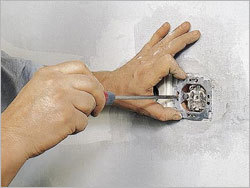
Installation of a plastic box
Installing the outlet
- The winding is removed from the ends of the wire cores at a distance of 1-1.5 cm from the end. If the cores of the wire consist of many wires, then we twist them into one tight bundle;
- We attach the conductors to screw or spring clamps;
- We hide the remaining excess wire under the bottom of the socket box;
- We insert the base of the socket into the socket and fix it with screws;
- We put the socket cover in place.
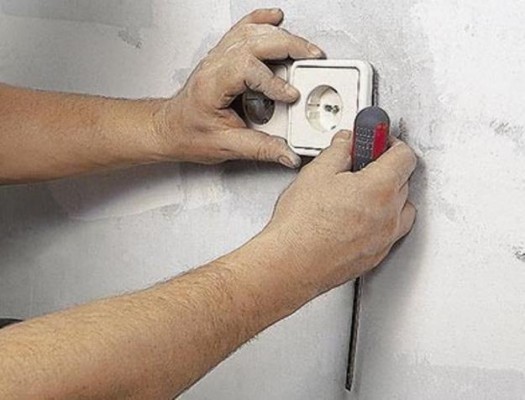
Installing the socket cover
That's all! You installed the new outlet yourself.
Summarize
Now you know how to make DIY sockets in the kitchen. As you already understood, the arrangement of outlets can be any - it all depends on your needs and desires. If something is not clear to you or requires a little clarification, then a photo and video instruction is presented for you, which will tell you about all types of work and features of sockets in more detail.

